|
| Links | email Sam Droege sdroege@usgs.gov for a excel spreadsheet of ID information for the Eastern Melandrena males
- Hosts
|
80x5 -
240x3 -
240x4 -
320x1 -
320x2 -
320x3 -
640x1 -
640x2
Set display option above.
Click on
images to enlarge. |
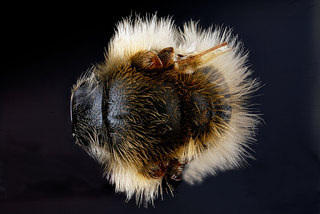
© Copyright source/photographer
· 9
Andrena vicina, -male, -pronotal-collar, -dorsal 2012-07-19-16.57.30 |
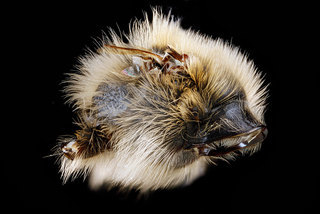
© Copyright source/photographer
· 9
Andrena vicina, -male, -pronotal-collar, -side 2012-07-19-17.04.10 |
|
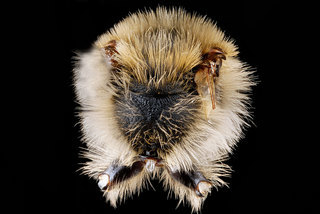
© Copyright source/photographer
· 9
Andrena vicina, -male, -propodeal-triangle 2012-07-19-17.14.01 |
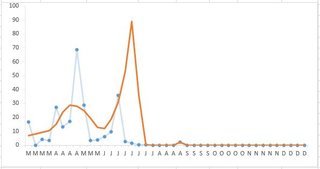
© Copyright source/photographer
· 9
Andrena vicina, Mid-Atlantic Phenology |
|
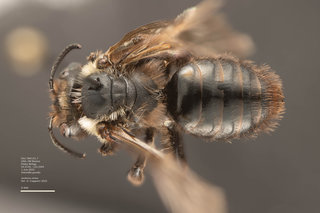
© Copyright source/photographer
· 9
Andrena vicina, female, dorsal, DLC |
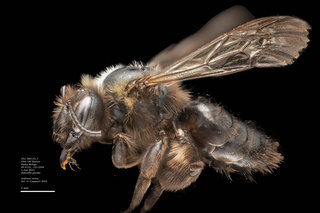
© Copyright source/photographer
· 9
Andrena vicina, female, lateral, DLC |
|
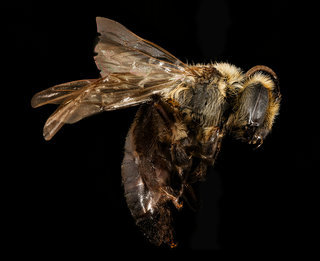
© Copyright source/photographer
· 7
Andrena vicina, f, right side, Hardy Co., WV |
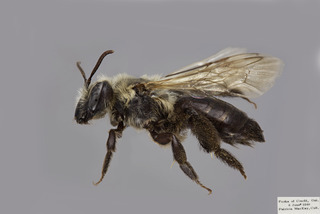
© Copyright Laurence Packer 2014
· 7
Andrena vicina FEM comp |
|
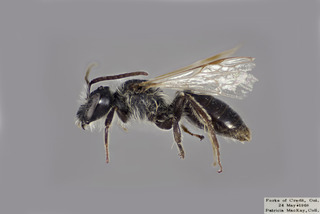
© Copyright Laurence Packer 2014
· 7
Andrena vicina MALE CFP comp |
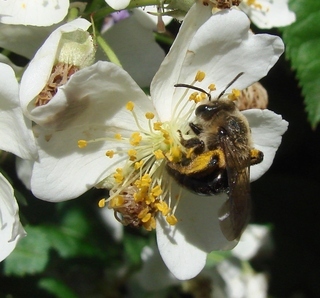
© Copyright John Ascher, 2006-2014
· 6
Andrena vicina |
|
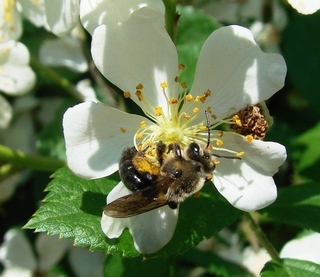
© Copyright John Ascher, 2006-2014
· 6
Andrena vicina |
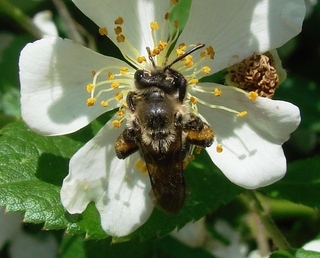
© Copyright John Ascher, 2006-2014
· 6
Andrena vicina |
|
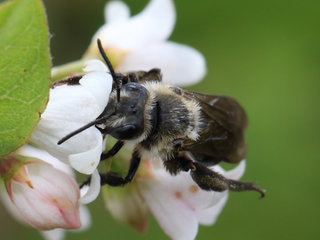
Michael Veit · 6
Andrena vicina, f on Apocynum -- |
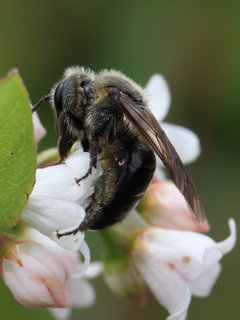
Michael Veit · 6
Andrena vicina, f on Apocynum -- |
|
Overview |
Reprinted with permission of the American Entomological Society from:
Bouseman, J. K., LaBerge, W. E. 1978. A revision of the bees of the genus Andrena of the Western Hemisphere. Part IX. Subgenus Melandrena. Transactions of the American Entomological Society 104: 275-390.
Please report text errors to: leah at discoverlife dot org.
Andrena vicina is a common bee of southern Canada and northern United States. It is similar to A. carlini but the female has the trochanteral flocculus only weakly formed (basal half with short hairs), the labrum usually lacks the median crista below the process, and the propodeum is more coarsely sculptured as described below. The male of vicina differs from that of carlini by the sixth sternum having the apical margin not at all produced medially and the propodeum more coarsely sculptured. The description below is complete and not compared with that of carlini, since vicina will stand as the prototype for the several species which follow.
Several of the references given in the synonymy above were not verified by the authors, as the specimens are no longer extant or are unavailable for study. It is quite possible that some of the early references refer to similarly colored species, such as A. carlini or A. regularis, which were not described at that time.
FEMALE. MEASUREMENTS AND RATIOS. � N = 20; length, 10-15 mm; width, 3-5 mm; wing length, M = 5.00A0.212 mm; FL/FW, M = 1.01 ;l 0.005; FOVL/FOVW, M = 3.15 � 0.056.
INTEGUMENTAL COLOR. � Black except as follows: mandible with apical third to half rufescent; flagellar segments below dark brown; wing membranes slightly infumate, yellowish-brown, veins dark reddish-brown to black; terga apical areas slightly translucent, rarely with basal areas with dark rufescent reflections; sterna with narrow apical areas hyaline, yellow; distitarsi often dark rufescent; tibial spurs yellow.
STRUCTURE. � Antennal scape length equal to about first three and one-half flagellar segments or slightly longer; flagellar segment 1 shorter than segments 2 plus 3; segment 2 shorter than 3 and about as long as broad; segments 3-10 longer than broad. Eyes each about three and three-fourths times as long as broad, inner margins converging slightly toward vertex. Mandible bidentate, in repose surpassing midlabrum by about one-fourth mandible length or slightly less. Malar space with minimum length equal to about one-fifth width of mandible base or slightly longer. Galea pointed, broad, apicolateral margin slightly concave; surface dulled by fine dense reticular shagreening; stipes abundantly punctate especially in lower half, with longitudinal striations, surface shiny. Maxillary palpus long, segmental ratio about as 1.0:1.0;0,8:0.8:0.7:0.6. Labial palpus with first segment curved, slightly flattened, segmental ratio about as 1.0:0.6:0.4:0.4, Labral process large, trapezoidal to rounded, entire or extremely weakly emarginate, shiny, with few weak transverse striations near base; labrum below process with transverse sulcus crossed by several extremely weak cristae, strong median crista present or absent. Clypeus with moderately large round punctures separated mostly by half a puncture width or slightly more, with complete median impunctate line but often narrow, surface shagreened in basal third to half, rarely entirely, apical half more or less shiny. Supraclypeal area with minute crowded punctures dulling surface. Face above antennal fossae with longitudinal rugae extending to ocelli or above and interrugal punctures, shagreened. Facial fovea shallow, long, extending below to a line below lower margins antennal fossae; above separated from lateral ocellus by about three-fourths an ocellar diameter. Vertex tall, above lateral ocellus equal to two ocellar diameters or almost, dulled by abundant punctures and fine tessellation. Genal area in profile equal to about one and two-thirds width of eye; with minute sparse punctures, dulled by reticular shagreening except in narrow band near eye margin and just above base of mandible.
Pronotum without angle or dorsoventral ridge; surface dull, finely shagreened with minute scattered punctures. Mesoscutum with small shallow punctures separated by half to one puncture width except posteromedially where sparse, surface dulled by fine reticular shagreening. Scutellum with similar punctures crowded peripherally and along midline. Metanotum dulled by dense punctures and fine shagreening. Propodeum with dorsal enclosure granular especially in basal half and often medially to apex, tessellate; dorsal surface outside of enclosure and posterior surface moderately roughened by round punctures separated by half to two puncture widths and dulled by coarse tessellation; lateral surface with coarse tessellation and scattered piliferous punctures, moderately shiny. Mesepisternum dulled by small obscure punctures separated mostly by one puncture width and fine . regular tessellation. Pterostigma about as broad as from inner margin prestigma to wing margin; second submarginal cell large, almost rectangular, receiving vein 1st m-cu near middle of cell; vannal lobe hind wing broad, long with deep excision. Tibial spurs and tarsal claws normal.
Metasomal tergum 1 with basal area punctures minute, separated by two to three puncture widths or more; apical area impunctate or with several punctures especially laterally; surface shiny to moderately so, shagreening weak (usually more evident in apical area), reticulotransverse. Tergum 2 similar but punctures more abundant, separated by one to two puncture widths or slightly more, apical area punctures slightly more abundant, surface usually shagreened but moderately shiny. Terga 3 and 4 similar to 2 but punctures progressively sparser and shagreening slightly more evident. Pygidial plate V-shaped with rounded apex, dull, without internal raised triangular area. Sterna 2-5 with apical areas impunctate, basal areas densely punctate apically to sparsely punctate basally; surfaces dulled by fine reticular shagreening.
VESTITURE. � Generally ochraceous except as follows; metasomal terga except tergum 1 with dark brown hairs; sterna dark brown; leg hairs brown to dark brown but femora often with pale hairs especially dorsally. Pollen-collecting hairs normal for subgenus but trochanteral flocculus with basal half with short plumose hairs and apical half with long curved plumose hairs sparse, short, suberect; dorsal thoracic hairs moderately long, erect, plumose.
MALE. MEASUREMENTS AND RATIOS. � N = 20; length, 9-13 mm; width, 2.0-3.5 mm; wing length, M = 4.26 � 0.242 mm; FL/FW, M = 1.00 � 0.007; FS1/FS2, M = 0.89 � 0.012.
INTEGUMENTAL COLOR. � Black except as follows: mandible with apical third rufescent; flagellar segments 3-11 dark brown to reddish-brown below; tegula often rufescent; wing membranes hyaline, colorless to yellowish, veins usually dark reddish-brown to brown; terga with apical areas translucent, yellow to brown, basal areas often with rufescent reflections; sterna 2-5 with apical areas translucent, yellow, basal areas rufescent; distitarsi dark rufescent, often basal leg segments dark rufescent; tibial spurs testaceous to yellow.
STRUCTURE. � Antennae long, in repose reaching posterior margin scutellum; scape length equals first two and one-third flagellar segments; flagellar segment 1 slightly shorter than segment 2 or no longer; segment 2 shorter than 3; segments longer than broad, segments 4 and 5 about one and one-third times as long as broad. Eyes, mandible, galea and malar space as in female. Maxillary palpus as in female but segmental ratio about as 1.0:1.0:0.8:0.7:0.6:0.7. Labial palpus as in female but ratio about as 1.0:0.6:0.5:0.5. Labral process large, entire to weakly emarginate, trapezoidal, shiny with few weak striations across extreme base; labrum below process not sulcate, shiny except minutely punctate immediately below process. Clypeus as in female but punctures often slightly coarser, without median impunctate line but punctures often sparser apicomedially, often shagreened, moderately shiny to shiny in apical half. Supraclypeal area, face above antennal fossae and vertex as in female. Genal area in profile one and one-half or more times as broad as eye, sculptured as in female but punctures usually more abundant.
Thoracic form and sculpturing as in female except as follows: mesoscutal and scutellar punctures sparser; propodeum with dorsal enclosure usually with short basal rugulae, dorsal surface outside of enclosure and posterior surface with punctures coarser, surfaces roughened, tessellate, and lateral surface with punctures more crowded especially in posterior half. Wing venation, tibial spurs and tarsal claws as in female.
Metasomal terga 1-5 sculptured as in female terga 1-4 but basal area punctures sparse, on tergum 2 separated mostly by three to four puncture widths. Tergum 7 with long pygidial area moderately shiny, about three to four times as long as broad, parallel-sided, rounded apex. Sterna 2-5 with apical areas impunctate, basal areas sparsely punctate, surfaces dulled by reticular shagreening. Sternum 6 with apical margin straight across, neither produced apicomedially nor emarginate, punctate except along midline and basally.
Terminalia as in figures 59-63; note gonocoxite with short dorsal lobe (dorsal view) and sternum 7 with shallow, broad emargination.
VESTITURE. � Generally pale ochraceous to ochraceous, slightly darker on vertex and thoracic dorsum except as follows: terga 2-5 often with basal area hairs light brown (especially terga 3-5); terga 6 and 7 with medial long hairs usually golden-brown; inner surfaces basitarsi pale yellow. Terga without pale pubescent fasciae.
Reprinted with permission from: Mitchell, T.B. 1960. Bees of the Eastern United States. North Carolina Agricultural Experiment Station Technical Bulletin No. 141.
FEMALE. � Length 13 mm.; clypeus convex, projecting full one-half below suborbital line, rather smooth, with a rather narrow and indefinite, median, impunctate line, rather deeply and closely punctate on each side; facial foveae broad above, occupying most of space between eyes and lateral ocelli, covered with brownish-ochraceous tomentum and with numerous longer, erect, more fuscous hairs; space between margin of vertex and lateral ocelli subequal to distance between them; cheeks slightly broader than eyes, rounded posteriorly, rather smooth, punctures very minute and obscure; length of malar space about one-third basal width of mandibles; basal segments of flagellum subequal to 2nd and 3rd combined; process of labrum broad and rather short, semicircular; pubescence of head and thorax entirely pale ochraceous, quite short; thoracic integument dull, punctures of scutum rather fine and close anteriorly, becoming quite sparse in center posteriorly, those on scutellum rather irregular, sparse on each side of middle, rather fine; pleura more densely tessellate, punctures very fine and obscure, rather close; enclosure of propodeum subrugose, rather coarsely so basally; propodeal corbicula well developed but rather short, with a distinct anterior fringe, pale ochraceous; trochanteral floccus rather short, pale fuscous; tibial scopa dense, black, hairs simple, rather elongate; pubescence of legs black, all basitarsi slightly narrower than their respective tibiae; 2nd submarginal cell slightly shorter than 3rd, receiving 1st recurrent near middle; abdominal terga shining, apical depressed areas rather obscure medially where they occupy about one-third length of discs, becoming faintly reddened toward rims, punctured about as basal areas of discs where punctures are quite fine, evenly distributed, rather close, somewhat more sparse in center and on basal tergum, pubescence of basal tergum pale, discal pubescence of following terga very short, thin, entirely fuscous to black, fasciae not developed, tergum 5 with a dense, apical, blackish fimbria.
MALE. � Length 11 mm.; clypeus rather strongly convex, projecting nearly one-half below suborbital line, rather coarsely and deeply punctate, punctures somewhat sparse medially, becoming close and relatively fine laterally; distance between margin of vertex and lateral ocelli subequal to distance between ocelli; cheeks broader than eyes, rounded posteriorly (as in hilaris, fig. 21), dull, minutely and rather closely punctate; length of malar space equal to about one-third basal width of mandibles; basal segment of flagellum subequal to 2nd segment; process of labrum quite large, subtriangular, apex rather broadly truncate; mandibles rather slender, slightly curved, with a robust, subapical, inner tooth, overlapping about one-third; pubescence of head, thorax and legs entirely pale, more whitish below, pale ochraceous above; thoracic integument dull, punctures of scutum rather fine and shallow, well separated but not sparse anteriorly, becoming more sparse in middle posteriorly, those on scutellum more fine and irregular, somewhat sparse on each side of shallow, fine and rather obscure; enclosure of propodeum dull, densely tessellate, subrugose toward basal margin; all basitarsi slender and elongate, considerably narrower than their tibiae; 2nd submarginal cell slightly shorter than 3rd, receiving 1st recurrent near middle; abdominal terga quite smooth, apical depressed areas distinct, occupying medially not quite one-third length of disc, becoming reddish-hyaline toward rims, much more finely and sparsely punctate than the more basal part of discs where punctures are very fine and distinct, well separated but not sparse, becoming rather close toward sides, discal pubescence erect, short and thin, somewhat more elongate on basal tergum, fasciae not developed; apical portion of sternum 8 quite slender, with a median ventral protuberance, densely pubescent from this to the rather narrowly truncate apex; penis valves gradually broadened toward base, not excavated, gonocoxites elongate, only slightly dilated apically, gonocoxal lobes very slightly produced, narrowly rounded apically (armature similar to that of commoda, fig. 22).
DISTRIBUTION. � Oregon and British Columbia, east to Nova Scotia and the New England states, south to North Carolina and Georgia; March to August.
FLOWER RECORDS. � Azalea, Castanea, Ilex, Malus, Padus, Prunus, Pyrus, Rhododendron, Rhodora, Rubus, Vaccinium and Viburnum. Recorded by Brittain and Newton (1933 & 1934) on the following additional genera: Amelanchier, Caragana, Narcissus, Salix, Scilla, Spiraea, Taraxacum, Trifolium and Tulipa.
Description based on the synonymous name: Andrena victima
The type specimens of victima F and desponsa 8 are both stylopized and as a result are neither normal nor acceptable representatives of the species to which they belong. It seems possible that they are synonymous with vicina. The male (desponsa) especially bears a very close resemblance to that of vicina and the differences may be due to its stylopized condition. The female (victima) differs from vicina in the color of the tibial scopa. This is black in normal females of vicina, but in the males the tibial pubescence is pale. In the stylopized type of victima the hind tibia is slightly narrower than that of vicina, and the scopal hairs are shorter. Those hairs near the middle of the tibia are yellowish, but those at apex, base and along hind margin are more fuscous. Again, it seems quite possible that these differences are due to stylopization. No apparent normal females that seem to agree with victima have been found. The other specimens in the original type series also are stylopized, and one of those was made a homotype and is in the possession of the writer. A homotype of desponsa also is at hand.
|
|
|
Identification | |
Extracted from: Charles, R. (1895). Notes on bees, with Descriptions of New Species. Transactions of the American Entomological Society Vol. 22, No. 2. pp. 115-128.
This is a common and very variable species. In Illinois the com
mon form has the pubescence of the head black, except a little
ochraceous about the base of the antennae and on the vertex ; some
times there is no ochraceous pubescence on head, except a slight
indication on the vertex. The thorax is ochraceous above, but some
times this color extends to the hairs beneath ; elsewhere the pubescence is black, but specimens in which the ochraceous predominates
sometimes show a pale floccus. I suspect that A. errans Sm. is only
a variety of this species.
|
|
|
Names | |
|
|
| Supported by | |
Updated: 2024-04-25 01:56:50 gmt
|